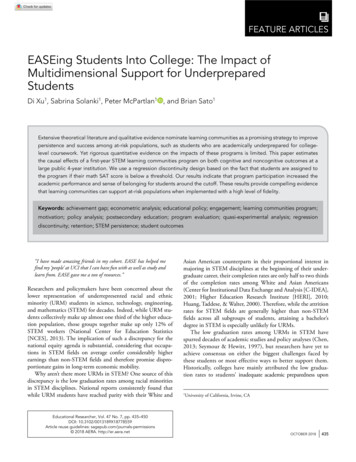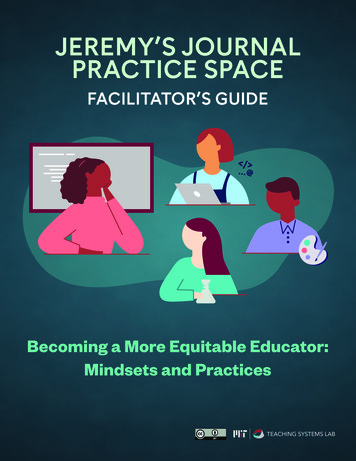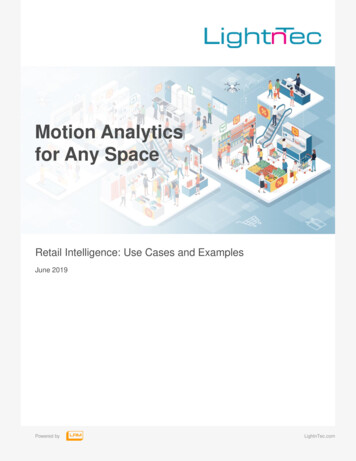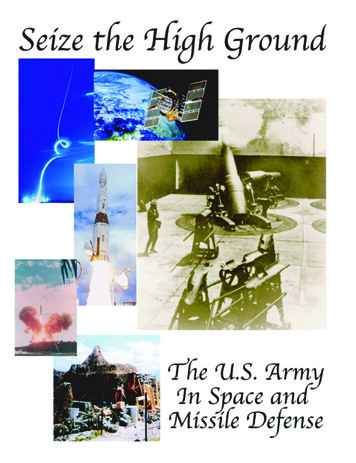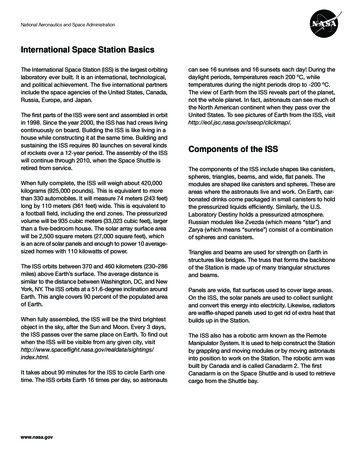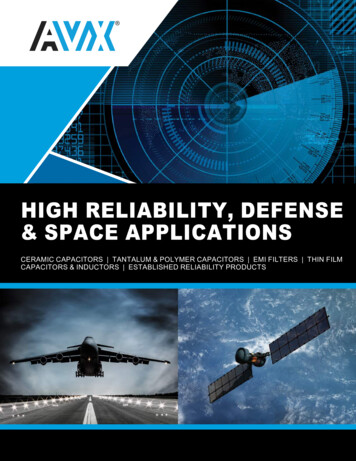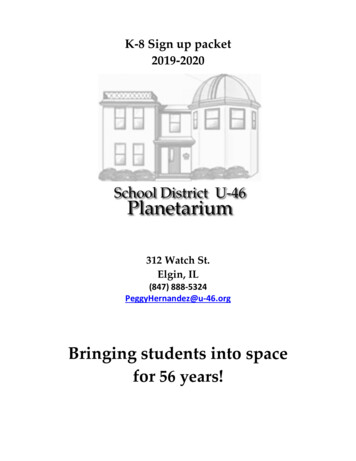
Transcription
K-8 Sign up packet2019-2020312 Watch St.Elgin, IL(847) 888-5324PeggyHernandez@u-46.orgBringing students into spacefor 56 years!
Sign Up Due Date: Thursday 8/29/2019 In compliance with U-46 student travel policy, signed planetarium permission slips (category 1) must becollected by the classroom teacher before the visit. Also, one adult in addition to the teacher is asked toattend the Planetarium lesson. The permission slip and travel policy is attached to your email and theprincipal notification is available on the Intranet under district forms (scroll down).I will send out 8th grade visits via email within a few weeks. I hope to have 1st grade and some 6th grade scheduled and notified by November. Notifications will be alittle later previous years due to the addition of 8th grade that has to visit by October 4th. You will receive an initial notification when you get scheduled and then also a reminder 2 weeks before.Changes are generally not possible after the reminder is sent, only forfeitures. Signups attempted after Aug. 29 will not be accepted. A possible second round of sign-ups will open withanother Google form around February/March if there are any openings at all. Please do not email me toask to sign up late.Planetarium Scheduling & Procedures1. Please use the link in your email to access the planetarium sign up form or click here. You must be signedinto your U-46 Google account. The planetarium will generate a date/time based on your request and notifyyou via email by December. If you have not heard from the planetarium by December, emailpeggyhernandez@u-46.org an inquiry about the status of your submitted request.2. All bus arrangements are made through the planetarium. Teachers do not arrange or contacttransportation. The bus will be at your school at the time listed in your notification in order to get youhere on time. There will be groups scheduled just before and/or after you. If you are late, your session willbe shortened and it may possibly shorten rest of the classes that day. Please be ready and on the lookoutfor the bus at your listed time. Transportation does not call school offices upon arrival.3. For security reasons, the outside door is always locked. As soon as a previous class is exiting, you may exitthe bus and come up the stairs. If the weather is nice feel free to bring the students out to wait on the stairs.Do not exit the bus if it is raining and the previous class is not exiting the building. If I am not with a class Iwill greet you at the door at your scheduled time.4. Students are encouraged to come empty handed. No writing utensils needed unless we are specificallyrecording measurements or making drawings. Backpacks are not needed and take up valuable space.5. No cell phones or electronic devices turned on during the presentation, please!6. The single stall bathroom is for emergencies only.7. No food, gum or drinks in the planetarium chamber (except medical necessity).8. If you need a wheelchair accessible bus, be sure to mark it on your submission and/or be sure I know inadvance. That bus is available only certain times of the day and I will schedule accordingly.
U-46 Planetarium Program Outline – Lesson Sequence K-8, 2019-2020Each Lesson includes astronomy content through a PPT presentation or a full dome (listed in italics) video, andsome time under the stars. The content is aligned with the Illinois State Science Standards (NGSS).GradeLESSON PRESENTEDKdg*One World, One Sky, What is a planetarium? Introduce constellations, explore sun in day (warm and bright)and no sun at night (cooler, dark), the longer the sun is up, the warmer Earth gets K-PS3-11*The Moon: focus on observing, describing and predicting observable changes in sky (Moon phase patterns);explore illumination-ours eyes work when light comes from or hits an object, notice the Sun is higher in thesummer and lower in the winter at noon, observe night constellations 1-ESS1-1, 1-ESS1-2, 1-PS4-22Rocky Earth in Space: Sort planets and rocks by observable properties, rocks change slowly and can changefast, how old is old? What happens to rock hit by an asteroid? Did an asteroid kill the dinosaurs? Observenight sky constellations, rotate vs revolve 2-PS1-1, 2-ESS1-14Cosmic Collisions and Time Telling: observe satellite imagery for evidence of collisions, using Earth(rocks) historical research, iridium layer/dinosaurs, delve into the history of the Elgin Natl. Watch Companyand how it was used to tell time, possible tour of transit scope upstairs 4ESS1-1, 4ESS2-1, 4ESS2-2, 4PS31, 4PS3-3, SS.EC.2.4, SS.G.2.45Celestial Movement and Patterns: what yearly, monthly and daily patterns we see and why--makepredictions based on what we see, differences in brightness of stars, What about the North Star? *Earth,Moon& Sun animations 5ESS1-2, 5ESS1-1, 5PS2-16Forces and Motion in Space: how objects move everywhere, motion (kinetic energy) as related to objectsin solar system, gravity and orbital motion, unbalanced forces and collisions, can we get hit by an asteroid?How did ancient people explain the sky? *Legends of the Night Sky: Perseus and Andromeda MS-PS2-2,MS-PS3-1, MS-PS2-1, SS.H.1.6-8, SS.H.2.6-88Models of our Solar System: review time telling in the ENWC Observatory and historical context ofbuilding, rotation vs. revolution with visuals, focus on movements of the moon as compared to earth, explorenorth pole views vs. side views vs. view from Earth in diagrams, observe the past 24 hours and makepredictions for the moon next week MS-ESS1-1, MS-ESS1-2, MS-ESS1-3, MSPS2-2, SS.H.1.6-8, SS.EC.2.6-8*Full Dome: full dome (italicized) shows project video recorded programs across most of dome surfaceProgram Times: Lessons in the planetarium are 60 minutesSeating Capacity: Maximum of 60 in grades K-3, Max of 55 for grades 3 and up. The max is total # of adults ANDchildren. Lesser numbers are better for full dome video viewing.Accessibility: The building is handicapped accessible and can accommodate up to three wheelchairsMulti-level (split) classes: The LOWER grade level show is presented, but enrichments/modifications are addedas appropriate.
The Elgin National Watch Company Observatory andElgin School District U-46 PlanetariumParent informationThe Elgin National Watch Company (ENWC) was founded in Elgin in 1864 and went on to make over 60 million watches inits almost 100 years in business. Part of that success was due to the precise time measurements made by the observatorythat the company built on Watch St. in Elgin in 1910 a few blocks from the factory. Astronomers hired by ENWC tracked themovement of stars at night and calculated the exact time using those measurements with the help of regulator clocks foralmost 40 years inside the building.Unfortunately, the ENWC went out of business, but in 1960 they gave the building to Elgin School District U-46 to use as aresource for astronomy education. The observatory and telescope were already outdated by that time, but today it is aplace of historical significance to Elgin and the history of time-telling.In 1963 the district built a planetarium addition to the building. A planetarium is a classroom specially equipped to teachastronomy. Over 1 million students have passed through the doors since it opened 55 years ago to learn about Earth, skyand space. Nearly all of them have been U-46 students. In addition to being a full time classroom during the school year, theplanetarium has been a venue for evening shows, after school clubs (Jr. Astro Society, Ham Radio Club, Antique Radio Club,summer camps, scout groups, etc ) and other special events. It is utilized full time for science lessons.Your son or daughter’s class has been scheduled to come to the planetarium for a lesson. These visits are offered at nocharge to students within the U-46 boundaries. The programs offered at the planetarium align with current IL learningstandards and complement each other as students progress up grade levels. The session always includes some time underthe stars looking at constellations and the nighttime movement of the sky using the original star projector, the same oneMr. Tuttle and Mr. Kutina used for 50 years! There is also a focus topic (seasons, solar system objects, etc ) for each visit.This topic is presented through a power point lecture, full dome video projection and/or activity.This visit is considered a science lesson in a U-46 classroom and there is no charge. The session under the dome is 1 hour.The entire visit takes about 1.5-2.5 hours depending on the distance from your child’s school to the Planetarium at 312Watch St. A separate permission slip is required to be signed and returned to the classroom teacher (NOT THEPLANETARIUM). One chaperone in addition to the teacher will attend the session.Occasionally the planetarium is open for special public shows in the evening. The dates, times and details for these areposted on the observatory/planetarium section of the U-46 website. The evening shows are 3.00 per person (any age) or 10.00 max per family. The evening shows offer a self-guided tour through the building to see the old equipment before theshow. There are no reservations, but seating is limited.For more information and public show dates visit www.u-46.org and follow “departments” to “Observatory/Planetarium”.Please do not wear light up shoes or glow in the dark items on that day! Feel free to contact me with any questions.Sincerely,Peggy Hernandez, U-46 Planetarium Teacherpeggyhernandez@u-46.org (847) 888-5324
El Observatorio de la Empresa Nacional de Relojes Elgin y elPlanetario del Distrito Escolar U-46Información para PadresLa Empresa Nacional de Relojes Elgin (ENWC, por sus siglas en inglés) fue fundada en Elgin en elaño 1864 y pasó a hacer más de 60 millones de relojes en sus casi 100 años en el negocio. Parte de ese éxito se debe a lasmedidas de tiempo precisas realizadas por el observatorio que la empresa construyó en la calle Watch en Elgin en el año1910, a pocas cuadras de la fábrica. Los astrónomos contratados por ENWC siguieron el movimiento de las estrellas en lanoche y calcularon la hora exacta utilizando las mediciones con la ayuda de los relojes del regulador dentro del edificiodurante casi 40 años.Desafortunadamente, la Empresa Nacional de Relojes Elgin (EWNC) cerró sus puertas, pero en el año 1960 le dieron eledificio al Distrito Escolar U-46 de Elgin para su uso como un recurso para la enseñanza de la astronomía. El observatorio yel telescopio ya estaban fuera de moda en ese momento, pero hoy en día es un lugar de importancia histórica para Elgin ypara contar la historia del tiempo.En el año 1963, el distrito le construyó una adición al edificio del planetario. Un planetario es un salón de claseespecialmente equipado para enseñar astronomía. Más de 1 millón de estudiantes han pasado por sus puertas desde queabrió hace 50 años para aprender sobre la tierra, el cielo y el espacio. Casi todos ellos han sido estudiantes del Distrito U-46.Además de ser un salón de clase de tiempo completo durante el año escolar, el planetario ha sido un lugar paraespectáculos nocturnos, clubes después de la escuela (Jr. Astro Society, Ham Radio Club, Antique Radio Club, campamentosde verano, grupos de scout, etc.) y otros eventos especiales. Se utiliza de tiempo completo para las clases de ciencia.La clase de su hijo o hija ha sido programada para visitar el planetario para una lección. Estas visitas se ofrecen sin costoalguno a los estudiantes que viven dentro de los límites del Distrito U-46. La mayoría de los estudiantes de escuelaselementales visitan el planetario una vez por año escolar, aunque hay algunas excepciones. Los programas que se ofrecenen el planetario se alinean con los estándares actuales de aprendizaje del Estado de Illinois y se complementan entre sí yaque los estudiantes avanzan en los niveles de grado. ¡La sesión siempre incluye un tiempo bajo las estrellas mirando lasconstelaciones y el movimiento del cielo en la noche usando el proyector original de las estrellas, el mismo que el Sr. Tuttley el Sr. Kutina utilizaron en los últimos 50 años! También hay un tema central por cada visita (estaciones, los objetos delsistema solar, fases lunares, etc.). Este tema se presenta como una lección a través de una presentación de power point,un video completo del domo y/o actividad.Esta visita se considera una clase de ciencias en un salón de clase de U-46 y no hay ningún costo. La sesión bajo el domo esde 1 hora. La visita completa dura alrededor de 1:30 a 2:30 horas o más dependiendo de la distancia de la escuela de su hijoal el planetario que está localizado al 312 Watch St. en Elgin. Una autorización separada debe de ser firmada y regresada alsalón de clase (NO AL PLANETARIO). Un acompañante además del maestro asistirá a la sesión.En ocasiones, el planetario está abierto en la noche con presentaciones especiales para el público. Las fechas, horarios ydetalles para estas presentaciones están publicadas en el sitio web de U-46 bajo el enlace "District Information”. Laspresentaciones en la noche son de 3.00 por persona (sin importar la edad) o 10.00 máximo por familia. Laspresentaciones en la noche ofrecen un recorrido por el edificio para ver los equipos antiguos antes de la presentación. Nose requiere reservaciones, pero los asientos son limitados.Para más información en las fechas de las presentaciones para el público por favor visite el sitio web del Distrito U-46 y sigael enlace bajo “Student Learning”¡Por favor, en ese día no use zapatos con luces o artículos que brillan en la obscuridad! Si tiene alguna pregunta por favorcomuníquese conmigo.Atentamente,Peggy Hernandez, Maestra del Planetario de U-46 Planetariumpeggyhernandez@u-46.org (847) 888-5324
for the bus at your listed time. Transportation does not call school offices upon arrival. 3. For security reasons, the outside door is always locked. As soon as a previous class is exiting, you may exit the bus and come up the stairs. If the weather is nice f






